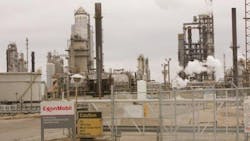Exxon Mobil Corp.’s (IW 500/1) biggest profit miss in at least a decade is the starkest sign yet that major oil explorers remain mired in the deepest market slump in a generation.
After resisting the industry trend of discounting the value of oil and natural gas fields that turned into money-losers amid the 2 1/2-year market slump, Exxon capitulated on January 31 and took a $2 billion hit on the value of some Rocky Mountain gas. Shares fell 2% to $83.16 at 11:03 a.m. in New York.
For Exxon, it was the ninth-straight quarter of year-over-year profit declines, the longest such streak since at least 1988. The bleak result in Rex Tillerson’s final quarter at the helm was presaged last week when Chevron Corp. disclosed its first annual loss in at least 37 years and may signal a string of disappointing results from rivals Royal Dutch Shell Plc, BP Plc and Total SA in coming days.
The market collapse that crushed prices, dried up cash flow and prompted hundreds of thousands of job cuts across the industry aggravated the impact Exxon felt from its own stillborn Russian drilling venture, domestic legal disputes over whether the company engaged in climate-science deception and the loss of its gold-plated credit rating.
Exxon’s $2 billion writedown slashed fourth-quarter profit to $1.68 billion, or 41 cents a share, compared with $2.78 billion, or 67 cents, a year earlier, the Irving, Texas-based oil producer said in a statement on Tuesday. The per-share result was more than 40% lower than the average estimate of 21 analysts in a Bloomberg survey, the widest gap since at least 2006.
In his first month on the job, Chairman and CEO Darren Woods is looking to deepwater drilling in South America and West Africa, gas exports in the South Pacific and shale riches in the Permian Basin beneath Texas and New Mexico to bolster reserves and improve Exxon’s production and profit outlook.
The company agreed two weeks ago to shell out as much as $6.6 billion to double its Permian drilling rights in Exxon’s biggest transaction in 6 1/2 years. On January 31, Exxon unveiled plans to boost full-year capital spending by 14% to $22 billion.
Exxon also expects to follow through with most of the 4.6 billion-barrel reserves reduction it warned investors about in October because depressed prices made some fields unprofitable to drill, Vice President Jeff Woodbury said during a webcast on Tuesday. The disclosure will occur within the next two weeks, he said.
Bright Spot
About 3.6 billion barrels of reserves in the Canadian oil sands and the equivalent of another 1 billion barrels in other North American fields could fall off the company’s books if low energy prices persisted, Exxon said in October. That would equate to 19 percent of Exxon’s reserves and would be the largest de-booking since the 1999 merger that created the company in its modern form. Woodbury said an undefined portion of those revisions would be offset by new additions.
A rare bright spot for Exxon during the final three months of last year was Imperial Oil Ltd., the Canadian oil producer in which it is majority owner. Excluding one-time items, Imperial posted a per-share profit of C$0.54 (41 cents), compared with an average estimate of C$0.40, citing higher oil and gas output, as well as increased fuel sales.
Woods, an Exxon lifer whose responsibilities included overseeing the company’s fleet of refineries and chemical plants, became chairman and CEO on Jan. 1 after his mentor Tillerson was nominated for U.S. Secretary of State.
Brent Gain
Brent crude, the international benchmark, rose 14% to average $51.06 a barrel during the final three months of 2016, compared with $44.69 a year earlier, according to data compiled by Bloomberg. U.S. gas jumped 42 percent to an average of $3.177 per million British thermal units. Typically, about 60% of the output from Exxon’s wells is oil; the rest is gas and related byproducts.
By Joe Carroll
About the Author
Bloomberg
Licensed content from Bloomberg, copyright 2016.
